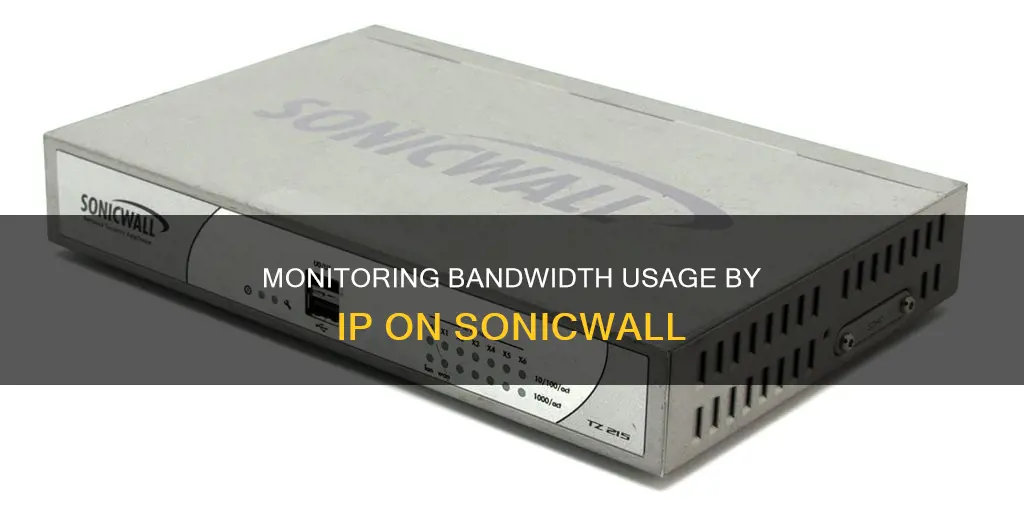
SonicWall offers a range of cybersecurity services, including firewall management and bandwidth monitoring. To monitor bandwidth usage per IP address, one can use the SonicWall Firewall Analyzer, which collects and analyses firewall traffic data to provide granular details about bandwidth usage. This tool allows users to monitor internet traffic in near real-time without the need for additional probes or collection agents. Additionally, the SonicWall dashboard provides a real-time monitor feature, enabling users to filter and view bandwidth usage for specific interfaces and applications.
| Characteristics | Values |
|---|---|
| Time Interval | Customisable |
| Grouping | User name, IP address, domain name, or auth type |
| Bandwidth Usage Display | Total bandwidth in MB, percentage, or current bandwidth in Kbps |
| Real-Time Monitoring | Available |
| VPN Connection Analysis | Available |
| Traffic Analysis | Available |
| Employee Internet Usage Monitoring | Available |
What You'll Learn

Using the SonicWall Firewall Analyzer
The SonicWall Firewall Analyzer is a powerful tool for monitoring and managing your SonicWall firewall. It offers a comprehensive set of features that enhance your network security and visibility.
With the Firewall Analyzer, you can access pre-defined reports that provide valuable insights into bandwidth usage and network activities. These reports help you identify security vulnerabilities, including denied hosts, blocked URLs, attacks, viruses, and affected hosts. This information is crucial for proactive security measures and network optimization.
One of the key advantages of the Firewall Analyzer is its ability to generate trend reports. These reports track patterns in network behaviour and bandwidth usage over time, enabling you to make informed decisions about capacity planning, business risk assessment, and bandwidth management. By understanding historical and current VPN connection trends, you can also troubleshoot VPN connections more effectively and identify potential security risks.
The Firewall Analyzer also simplifies the process of monitoring employee internet usage. By utilizing the employee internet monitoring report, you can fine-tune firewall policies to block or restrict bandwidth-intensive websites. This ensures that bandwidth is prioritized for business-critical functions, optimizing your network's performance.
Additionally, the Firewall Analyzer assists in SonicWall security audits. It provides compliance reports that help configure firewall rules to prevent unauthorized access to your network. By assessing issues and presenting results as statistics, the Firewall Analyzer empowers you to make data-driven decisions to strengthen your network security posture.
Monitoring CPU Usage: MSI Afterburner Guide
You may want to see also

Viewing SonicWall WAN bandwidth in real-time
To view SonicWall WAN bandwidth in real-time, you can use the real-time monitor and filter to match your desired interface. This will show you how much bandwidth is being used by that interface and which applications are utilising the bandwidth.
Alternatively, you can use GMS in distributed mode and set up a Flow Server to view this information from the GMS itself. This will allow you to see a breakdown of bandwidth usage by interface and identify what is using the traffic.
If you're looking for a more visual representation of your network bandwidth, you might want to try Cacti or Grafana (Cloud). Cacti is a free, open-source tool that specialises in creating network bandwidth diagrams. However, it requires some IaaS to run. Grafana (Cloud) is another option that provides similar functionality.
By utilising these tools and methods, you can effectively monitor and analyse your SonicWall WAN bandwidth in real-time, gaining insights into bandwidth usage per interface and the applications driving that usage.
Monitoring Router Bandwidth Usage: A Step-by-Step Guide
You may want to see also

Using GMS in distributed mode
The SonicWall Global Management System (GMS) is a powerful and intuitive solution for centrally managing and deploying SonicWall firewall, anti-spam, backup and recovery, and secure remote access solutions. GMS provides real-time monitoring and comprehensive policy and compliance reporting, helping to streamline security policy management and appliance deployment for enterprises and simplify security management for service providers.
To use GMS in distributed mode, follow these steps:
- Configure the firewall to send syslogs to GMS. Navigate to System > Administration in the firewall. For firewall firmware prior to 6.5.X.X, follow the steps under System > Administration > Advanced Management. For firewall firmware 6.5.X.X and newer, simply click Configure.
- Add the GMS IP address, which is the INTERNAL IP of the Primary GMS Console or All-in-One Internal IP.
- If GMS is behind a NAT device (i.e., across the WAN), check the "GMS Behind NAT Device" box and add the External IP of the device upstream of the server. Ensure the NAT device has the appropriate access rule and NAT policy allowing UDP 514 to the GMS Agent.
- If sending syslogs to a distributed agent, check the box for "Send Syslog Messages to a Distributed Reporting GMS Server" and add the Internal IP of that destination agent.
- Log into GMS and navigate to the Firewall Tab. Select "Add Unit".
- Add a Friendly Name, Serial Number, Admin Account, and Password. Choose SSL for the Management Mode and click OK. Ensure you add the correct port you are using to manage the firewall if it is different from the default port, 443.
- Select the AGENT IP Address of the Agent that you wish this device to report to. This can be modified later by right-clicking the firewall and selecting "modify agent", but this requires a similar change on the firewall.
Note that a typical distributed deployment consists of a Virtual Appliance or Windows server deployed as a Console or All-in-one server, with one or more of these devices deployed as Agents.
Monitoring Power Usage: Simple Steps for Your Home
You may want to see also

Using a Flow Server
To monitor bandwidth usage per IP address in SonicWall, you can utilise a Flow Server by following these steps:
Firstly, ensure that you have GMS (Geneva Management System) implemented with your SonicWall device. The GMS is a powerful tool that allows for centralised management and monitoring of SonicWall appliances.
Next, set up the GMS in distributed mode. This mode enables you to manage multiple SonicWall devices from a single interface, providing a comprehensive view of your network infrastructure.
Once GMS is configured in distributed mode, you can establish a Flow Server. The Flow Server acts as a central repository for network traffic data, collecting and storing information about bandwidth usage and traffic flow.
By accessing the Flow Server via the GMS interface, you can gain valuable insights into your network's performance and bandwidth consumption. The Flow Server provides real-time data, allowing you to monitor bandwidth usage per IP address. This detailed information helps you identify which applications and IP addresses are utilising the most bandwidth, enabling you to optimise your network's performance and allocate resources efficiently.
Additionally, the Flow Server offers the ability to set up alerts and notifications based on specific bandwidth usage thresholds. This feature ensures that you are proactively notified when bandwidth usage reaches a certain level, helping you to proactively manage your network and address any potential issues promptly.
By leveraging the capabilities of a Flow Server, you can effectively monitor bandwidth usage per IP address in SonicWall, making data-driven decisions to optimise your network's performance and security.
Monitoring Data Usage on iPhone: Tips and Tricks
You may want to see also

Using third-party software like Cacti or Grafana
To monitor bandwidth usage per IP address in SonicWall using third-party software like Cacti or Grafana, you can follow these steps and guidelines:
Cacti
Cacti is a powerful, open-source network monitoring tool that can be used to monitor bandwidth usage on your SonicWall device. Here's how you can set it up:
- Enable SNMP on SonicWall: Before you begin, ensure that Simple Network Management Protocol (SNMP) is enabled on your SonicWall device. This will allow Cacti to retrieve the necessary data. You can refer to SonicWall's knowledge base articles for guidance on enabling SNMP, depending on your specific operating system version.
- Install and Configure Cacti: Download and install Cacti on a machine that is accessible from your SonicWall device. During the installation, you may need to configure Cacti to use SNMP to retrieve data from your SonicWall device.
- Add your SonicWall Device: In Cacti, add your SonicWall device as a new device, providing the necessary SNMP credentials.
- Select the Interface: Specify the interface you want to monitor, such as "X1" on a SonicWall NS240 Firewall.
- Generate Graphs: Cacti will automatically generate graphs based on the data retrieved via SNMP. You can customize these graphs and create reports based on your specific requirements.
- Troubleshooting: If you encounter SNMP errors while adding your SonicWall device, ensure that your firewall is configured to allow SNMP requests from the Cacti system. You may need to verify the SNMP configuration and ensure that the necessary Object IDs (OIDs) are accessible.
Grafana
Grafana is another popular option for monitoring bandwidth usage on SonicWall devices:
- Choose a Data Source: Grafana is a visualization and analysis platform that can pull data from various sources, including Prometheus, InfluxDB, and MySQL. Choose a data source that suits your requirements and set it up within Grafana.
- Add SonicWall Data: Configure Grafana to pull data from your SonicWall device. This may involve setting up an integration or plugin specific to SonicWall.
- Create Custom Dashboards: Utilize Grafana's dashboarding features to create custom visualizations of your SonicWall bandwidth data. You can create graphs, charts, and alerts to monitor usage per IP address.
- Explore Plugins: Grafana has a rich ecosystem of plugins and integrations that can extend its functionality. Explore plugins specifically designed for network monitoring or SonicWall integration to enhance your bandwidth monitoring capabilities.
- Alerting and Notifications: Grafana allows you to set up alerts and notifications based on predefined thresholds. You can receive real-time updates when bandwidth usage crosses certain limits.
By leveraging third-party software like Cacti or Grafana, you can gain detailed insights into bandwidth usage per IP address on your SonicWall device, helping you make informed network management decisions.
Electricity Usage: Monitored by Companies or Not?
You may want to see also
Frequently asked questions
You can use the SonicWall Firewall Analyzer to monitor and collect data on internet traffic. This will allow you to view bandwidth usage per IP address.
You can use tools like Cacti or Grafana (Cloud) to monitor SonicWall WAN bandwidth in real-time. These tools can provide network bandwidth diagrams and help identify bandwidth usage per IP address.
Navigate to Dashboard | AppFlow Monitor | tab User. In the first tab Interval, select your desired time interval. In the second tab Group, choose IP address. This will display the total bandwidth usage in MB per IP address.







